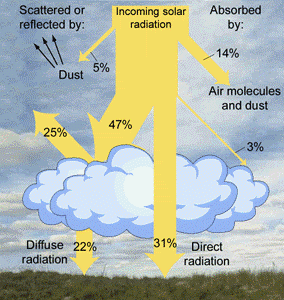12.3 Net Radiation
When the direct and diffuse shortwave (solar) radiation reach the land surface, some of this radiation is reflected by the surface. The fraction of the incoming shortwave radiation that is reflected by the surface is called the albedo. In general, dark surfaces have low albedo while light colored surfaces have high albedo. Fresh snow can have an albedo as high as 0.9, reflecting large portions of the incoming shortwave radiation. In contrast, the albedo of water is typically quite low, < 0.1, although it can be much higher when the sun angle is low. Soils and vegetation typically have intermediate values of albedo, ranging from 0.1 to 0.4. Moist soil surfaces are typically darker and have lower albedo values than do dry soil surfaces. Soil color is also affected by soil organic matter, with higher levels of soil organic matter resulting in darker soil and lower albedo.

In addition to the shortwave radiation, we need to account for the longwave radiation at the land surface. We have seen previously that the land surface emits longwave radiation to the atmosphere. But, we should not overlook the fact that the atmosphere emits longwave radiation both upward into space and downward toward the Earth’s surface. The magnitude of this downward longwave radiation depends on the temperature and emissivity of the atmosphere, according to Eq. 12-2. The atmospheric emissivity can range from 0.5 to nearly 1 [5]. The presence of clouds significantly increases the emissivity of the atmosphere, which is why, as you have perhaps noticed, cloudy winter nights are often warmer than clear winter nights. The amount of water vapor in the atmosphere also has a strong effect on the atmospheric emissivity, with higher emissivity values for more humid conditions [6].
Typically the largest term in the surface energy balance is the net radiation. Net radiation is simply the sum of all incoming and outgoing radiation fluxes at the land surface. Mathematically, net radiation, Rn, is given by:
![]()
(Eq. 12-3)
where α is the albedo, Rs is the incoming solar radiation (direct and diffuse), Rli is the incoming longwave, and Rlo is the outgoing longwave.

